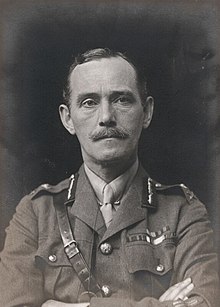Edward Northey (British Army officer)
CB | |
|---|---|
 | |
| Governor of Kenya | |
| In office 1919–1922 | |
| Monarch | George V |
| Preceded by | Charles Calvert Bowring |
| Succeeded by | Robert Coryndon |
| High Commissioner of Zanzibar | |
| In office 1922–1924 | |
| Personal details | |
| Born | 28 May 1868 Major-general |
| Unit | King's Royal Rifle Corps |
| Commands | |
| Battles/wars |
|
Birth and early career
Edward Northey was born in 1868 at Cockerham, Lancashire, and educated at Eton College and the Royal Military College, Sandhurst, being commissioned into the King's Royal Rifle Corps as a second lieutenant on 7 March 1888.[2][3] He was promoted to lieutenant on 7 May 1890, and served in expeditions to Hazara and the Miranzai Valley in 1891 and one to Isazai the following year. Promotion to captain followed on 1 July 1895.[4] From late 1899, Northey took part in the Second Boer War, remaining in South Africa until 1902.[3]
On his return, he was appointed adjutant of a volunteer battalion, the 1st Middlesex Rifles (Victoria and St. George′s).[5]
First World War
When the
Returning to the army in 1916 after recovering from his wound, Northey was posted to
Governor of the British East Africa Protectorate
At the war's end Northey was appointed
On 16 October 1919 The Times newspaper reported that Sir Edward Northey had met with an accident, while playing polo, which required the removal of his right eye. The accident occurred in British East Africa.[7]
In 1919, Northey issued a circular which instructed government officials to coerce African labour to work on European-owned farms and estates, despite earlier Colonial Office objections to this plan. The scandal generated by the Northey proposal caused the Colonial Office to make clear in 1921 that compulsory paid labour by local Africans could only be used on government projects, not to direct labour to European estates, and then only if absolutely necessary and with Colonial Office approval.[8]
In 1922, Northey was transferred to the lesser post of High Commissioner of Zanzibar, returning to Britain in 1924 to return to military service.[3]
Late career
On his return, Northey was placed in command of the
References
- ISBN 978-0-521-03367-1.
- ^ "No. 25793". The London Gazette. 6 March 1888. p. 1427.
- ^ a b c d e f g h Davies 1997, p. 173.
- ^ Hart′s Army list, 1903
- ^ "Naval & Military intelligence". The Times. No. 36953. London. 17 December 1902. p. 8.
- ^ Bloody Red Tabs claims that he was talking to Captain William Henry Johnston on 22 June 1915 when he was wounded, but Johnson had been killed on 8 June
- ^ The Times, London, 16 October 1919
- ^ O. Okia, (2008). The Northey Forced Labour Crisis, 1920–1921: A Symptomatic Reading. The International Journal of African Historical Studies, Vol. 41, No. 2 pp 263–4, 288
Bibliography
- Davies, Frank (1997). Bloody Red Tabs: General Officer Casualties of the Great War 1914–1918. ISBN 978-0-85052-463-5.
